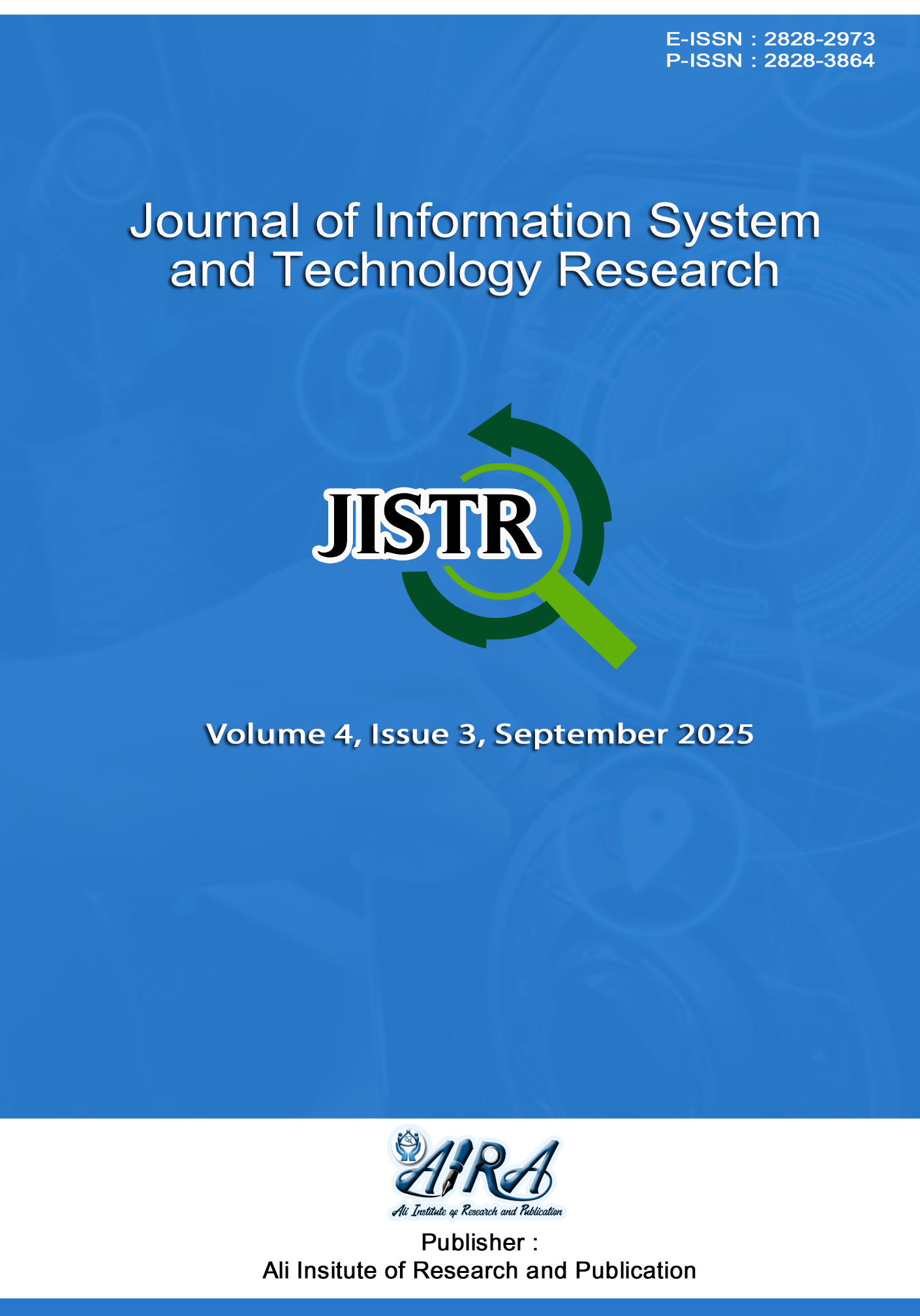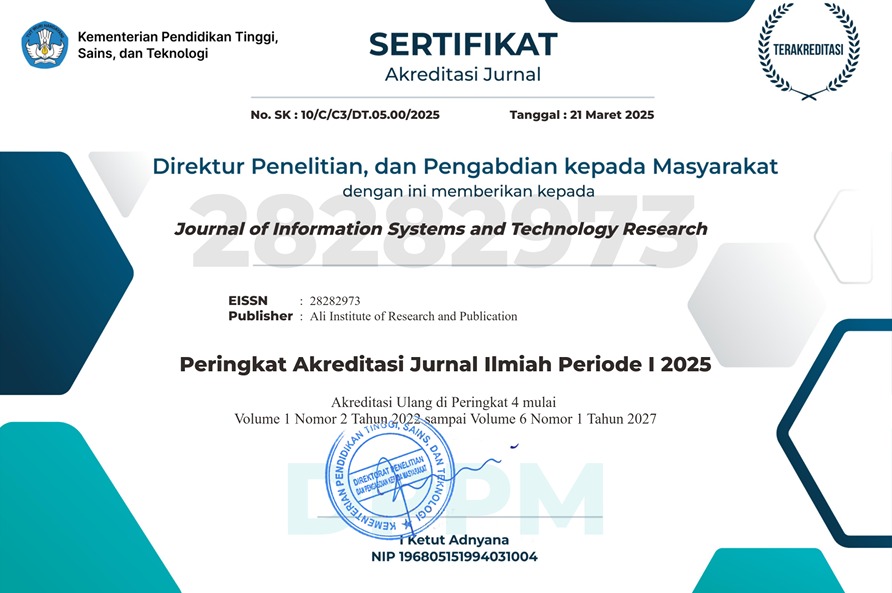Design and Implementation of a Dual-Cloud IoT Air Quality Monitoring System Using Fuzzy Mamdani Method
DOI:
https://doi.org/10.55537/jistr.v4i3.1326Keywords:
IoT, Air Quality Monitoring, Fuzzy Mamdani, ESP32, ThingSpeakAbstract
Air pollution continues to be a critical environmental issue that negatively impacts human health, ecosystems, and urban sustainability. Therefore, reliable air quality monitoring systems are urgently required to provide real-time and accurate information for both communities and decision-makers. This study presents the design and implementation of an Internet of Things (IoT)-based air quality monitoring system that integrates environmental sensors with an ESP32 microcontroller. A key novelty of this research is the adoption of a dual-cloud architecture, combining ThingSpeak and Blynk, to enhance data accessibility, visualization, and system reliability compared to conventional single-cloud approaches. The Fuzzy Mamdani method is applied to classify air quality levels into three categories: Good, Moderate, and Poor, using input variables of temperature, humidity, and gas concentration. Methodologically, the system was tested under multiple environmental conditions, and fuzzy membership functions and rules were carefully designed to reflect realistic thresholds. The results show that the dual-cloud system enables more robust and flexible monitoring, with faster data synchronization and higher reliability in remote visualization. Quantitatively, the system achieved a 92% expert validation score and demonstrated a 15% improvement in responsiveness compared to previous single-cloud implementations reported in the literature. The discussion highlights that dual-cloud visualization provides an effective solution to overcome downtime risks and single-point failures, while also improving user experience in accessing real-time air quality information. This research contributes to the growing body of work on IoT-based environmental monitoring and can serve as a foundation for future smart city applications.
Downloads
References
[1] R. F. Ningrum, R. R. A. Siregar, dan D. Rusjdi, “Fuzzy Mamdani logic inference model in the loading of distribution substation transformer SCADA system,” IAES Int. J. Artif. Intell., vol. 10, no. 2, hal. 298–305, 2021, doi: 10.11591/ijai.v10.i2.pp298-305.
[2] R. Delfianti, V. A. Tazayul, B. Mustaqim, F. Nusyura, dan C. Harsito, “Internet of Things ( IoT ) based Electrical Power Monitoring System for Solar Power Plants using the Telegram Application,” vol. 2, no. 3, hal. 428–443, 2025, doi: 10.26740/vubeta.v2i3.39405.
[3] M. S. Abubakari dan Mashoedah, “The Internet of Things (IoT) as an Emerging Technological Solution for the Covid-19 Pandemic Mitigation: An Overview,” J. Phys. Conf. Ser., vol. 1737, no. 1, 2021, doi: 10.1088/1742-6596/1737/1/012003.
[4] V. F. Amaliya et al., “Development of IoT-Based Volcano Early Warning System,” J. Phys. Conf. Ser., vol. 1772, no. 1, 2021, doi: 10.1088/1742-6596/1772/1/012009.
[5] R. A. Candra, Suherman, dan D. N. Ilham, “Amplitude range data validation in Internet of Things (IoT) sensor,” IOP Conf. Ser. Earth Environ. Sci., vol. 644, no. 1, 2021, doi: 10.1088/1755-1315/644/1/012063.
[6] Noeryanti, “Comparison of Fuzzy Mamdani and Backpropagation Artificial Neural Network Methods to Predict Yogyakarta Human Development Index,” Sttkao.Ac.Id, no. 11, hal. 11–12, 2011, [Daring]. Tersedia pada: https://sttkao.ac.id/storage/penelitian/5g_penelitian_bersama_finall_210722080700.pdf.
[7] A. Kamsyakawuni, “Application Fuzzy Mamdani To Determine The Ripeness Level Of Crystal Guava Fruit,” hal. 167–186, 2021.
[8] G. P. N. Hakim, R. Muwardi, M. Yunita, dan D. Septiyana, “Fuzzy Mamdani performance water chiller control optimization using fuzzy adaptive neuro fuzzy inference system assisted,” Indones. J. Electr. Eng. Comput. Sci., vol. 28, no. 3, hal. 1388–1395, 2022, doi: 10.11591/ijeecs.v28.i3.pp1388-1395.
[9] L. Noviasari dan Mashoedah, “Classification of Thorax X-ray Results on Corona Virus Infection Based on Internet of Things (IoT),” J. Phys. Conf. Ser., vol. 1737, no. 1, 2021, doi: 10.1088/1742-6596/1737/1/012001.
[10] L. Pamungkas, P. Rahardjo, dan I. G. A. P. Raka Agung, “Rancang Bangun Sistem Monitoring Pada Hidroponik Nft (Nurtient Film Tehcnique) Berbasis Iot,” J. SPEKTRUM, vol. 8, no. 2, hal. 9, 2021, doi: 10.24843/spektrum.2021.v08.i02.p2.
[11] C. Widiasari dan L. A. Zulkarnain, “Rancang Bangun Sistem Monitoring Penggunaan Air PDAM Berbasis IoT,” J. Komput. Terap., vol. 7, no. 2, hal. 153–162, 2021, doi: 10.35143/jkt.v7i2.5152.
[12] I. Gunawan, H. Ahmadi, dan M. R. Said, “Rancang Bangun Sistem Monitoring Dan Pemberi Pakan Otomatis Ayam Anakan Berbasis Internet Of Things (IoT),” Infotek J. Inform. dan Teknol., vol. 4, no. 2, hal. 151–162, 2021, doi: 10.29408/jit.v4i2.3562.
[13] D. Rika Widianita, “RANCANG BANGUN SISTEM PEMANTAUAN KUALITAS UDARA BERBASIS INTERNET OF THINGS (IoT) MENGGUNAKAN THINGSPEAK DAN WEBSITE,” AT-TAWASSUTH J. Ekon. Islam, vol. VIII, no. I, hal. 1–19, 2023.
[14] R. Muttaqin, W. S. W. Prayitno, N. E. Setyaningsih, dan U. Nurbaiti, “Rancang Bangun Sistem Pemantauan Kualitas Udara Berbasis Iot (Internet Of Things) dengan Sensor DHT11 dan Sensor MQ135,” J. Pengelolaan Lab. Pendidik., vol. 6, no. 2, hal. 102–115, 2024, doi: 10.14710/jplp.6.2.102-115.
[15] A. Thoriq, L. Hasta Pratopo, R. Mulya Sampurno, dan S. Hisyam Shafiyullah, “Rancang Bangun Sistem Monitoring Suhu dan Kelembaban Tanah,” J. Keteknikan Pertan., vol. 10, no. 3, hal. 268–280, 2022, doi: 10.19028/jtep.010.3.268-280.
[16] S. Mustafa dan U. Muhammad, “Rancang Bangun Sistem Monitoring Penggunaan Daya Listrik Berbasis Smartphone,” J. Media Elektr., vol. 17, no. 3, hal. 127, 2020, doi: 10.26858/metrik.v17i3.14968.
[17] P. Hidayatullah, M. Orisa, dan A. Mahmudi, “Rancang Bangun Sistem Monitoring Dan Kontrol Tanaman Hidroponik Berbasis Internet of Things (Iot),” JATI (Jurnal Mhs. Tek. Inform., vol. 6, no. 2, hal. 1200–1207, 2023, doi: 10.36040/jati.v6i2.5433.
[18] L. Wilani, M. Peslinof, J. Pebralia, P. Studi Fisika, F. Sains dan Teknologi, dan U. Jambi, “STRING (Satuan Tulisan Riset dan Inovasi Teknologi) RANCANG BANGUN SISTEM MONITORING KEBISINGAN PADA RUANGAN DENGAN SENSOR SUARA GY-MAX4466 BERBASIS INTERNET OF THINGS (IoT),” vol. 7, no. 3, hal. 319–328, 2023.
[19] G. Priyandoko, “Rancang Bangun Sistem Portable Monitoring Infus Berbasis Internet of Things,” Jambura J. Electr. Electron. Eng., vol. 3, no. 2, hal. 56–61, 2021, doi: 10.37905/jjeee.v3i2.10508.
[20] R. F. Maulana, M. A. Ramadhan, W. Maharani, dan M. I. Maulana, “Rancang Bangun Sistem Monitoring Suhu dan Kelembapan Berbasis IOT Studi Kasus Ruang Server ITTelkom Surabaya,” Indones. J. Multidiscip. Soc. Technol., vol. 1, no. 3, hal. 224–231, 2023, doi: 10.31004/ijmst.v1i3.169.
[21] B. Suhendar, T. D. Fuady, dan Y. Herdian, “Rancang Bangun Sistem Monitoring dan Controlling Suhu Ideal Tanaman Stroberi Berbasis Internet of Things (IoT),” J. Ilm. Sains dan Teknol., vol. 5, no. 1, hal. 48–60, 2020, doi: 10.47080/saintek.v5i1.1198.
[22] D. C. Nugroho et al., “Household electricity network monitoring based on IoT with of automatic power factors improvement using neural network method,” IOP Conf. Ser. Mater. Sci. Eng., vol. 1010, no. 1, 2021, doi: 10.1088/1757-899X/1010/1/012045.
[23] R. Riskaputra, Implementasi logika fuzzy mamdani dalam optimasi harga jasa distribusi produk (studi kasus: Kantor Konsultan Marketing RnD Enterprises). 2023.
[24] D. Hidayat dan I. Sari, “MONITORING SUHU DAN KELEMBABAN BERBASIS INTERNET of THINGS (IoT),” J. Teknol. Dan Ilmu Komput. Prima, vol. 4, no. 1, hal. 525–530, 2021, doi: 10.34012/jutikomp.v4i1.1676.
[25] D. A. Susilo, J. Maulindar, dan M. E. Yuliana, “Perancangan Alat Monitoring Kualitas Air Kolam Ikan Lele Berbasis Internet Of Things,” Innov. J. Soc. Sci. Res., vol. 3, no. 2, hal. 4703–4711, 2023, [Daring]. Tersedia pada: https://j-innovative.org/index.php/Innovative/article/view/628.
[26] A. Saputra dan M. Rahmadani, “Alat Monitoring dan Pemberian Pakan Ikan Otomatis berbasis Arduino Uno R3,” Snistek 4, hal. 37–42, 2022.
[27] H. Herpratiwi, M. Maftuh, W. Firdaus, A. Tohir, M. I. Daulay, dan R. Rahim, “Implementation and Analysis of Fuzzy Mamdani Logic Algorithm from Digital Platform and Electronic Resource,” TEM J., vol. 11, no. 3, hal. 1028–1033, 2022, doi: 10.18421/TEM113-06.
[28] M. Muthmainnah, Aan Syaifudin, dan Ninik Chamidah, “Prototipe Alat monitoring Suhu dan Kelembaban pada Rumah Penyimpan Tembakau Berbasis Internet of Thing (IoT),” J. Pendidik. Mipa, vol. 13, no. 1, hal. 177–182, 2023, doi: 10.37630/jpm.v13i1.853.
[29] J. W. Jokanan, A. Widodo, N. Kholis, dan L. Rakhmawati, “Rancang Bangun Alat Monitoring Daya Listrik Berbasis IoT Menggunakan Firebase dan Aplikasi,” J. Tek. Elektro, vol. 11, no. 1, hal. 47–55, 2022, doi: 10.26740/jte.v11n1.p47-55.
[30] T. Tamaji dan Y. A. K. Utama, “Implementasi Fuzzy Logic Untuk Kualitas Udara, Suhu, Dan Kelembaban Udara Berbasis Iot,” Foristek, vol. 14, no. 1, 2023, doi: 10.54757/fs.v14i1.249.
[31] R. Dwi Alfian dan D. Teknik Elektro, “‘Rancang bangun alat monitoring pemakaian tarif listrik dan kontrol daya listrik pada rumah kos berbasis internet of things’ RANCANG BANGUN ALAT MONITORING PEMAKAIAN TARIF LISTRIK DAN KONTROL DAYA LISTRIK PADA RUMAH KOS BERBASIS INTERNET OF THINGS Subuh I,” J. Tek. Elektro, vol. 10, hal. 661–670, 2021.
[32] A. F. H. Sitanggang dan Y. A. Prabowo, “Perancangan Alat Monitoring Arus Bocor pada Kabel 20 kV Menggunakan Filter Kalman Berbasis Internet of Things,” Elektrika, vol. 14, no. 2, hal. 41, 2022, doi: 10.26623/elektrika.v14i2.4849.
[33] A. R. C. Baswara dan R. Alfaqi, “Rancang Bangun Sistem Monitoring Pembangkit Listrik Tenaga Mikro Hidro Berbasis Internet Of Things (IoT),” J. Teknol. Elektro, vol. 14, no. 1, hal. 39, 2023, doi: 10.22441/jte.2023.v14i1.008.
[34] M. ghozi Arkhan dan Z. R. S. Elsi, “Air Quality Monitoring System Based Internet Of Things,” Brill. Res. Artif. Intell., vol. 4, no. 2, hal. 669–673, 2024, doi: 10.47709/brilliance.v4i2.4924.
[35] I. M. A. Iwan Wisnawa, A. M. Dirgayusari, I. G. M. Y. Antara, A. A. G. Ekayana, dan I. W. Sudiarsa, “Rancang Bangun Sistem Monitoring Panel Listrik dan Kontrol Listrik Kos Berbasis IoT,” J. Krisnadana, vol. 2, no. 1, hal. 211–221, 2022, doi: 10.58982/krisnadana.v2i1.230.
[36] M. Anitha dan L. S. Kumar, “Development of an IoT-Enabled Air Pollution Monitoring and Air Purifier System,” Mapan - J. Metrol. Soc. India, vol. 38, no. 3, hal. 669–688, 2023, doi: 10.1007/s12647-023-00660-y.
Downloads
Published
How to Cite
Issue
Section
License
Copyright (c) 2025 Fiqih Qodri Ramadani, Yusuf Ramadhan Nasution

This work is licensed under a Creative Commons Attribution-ShareAlike 4.0 International License.







